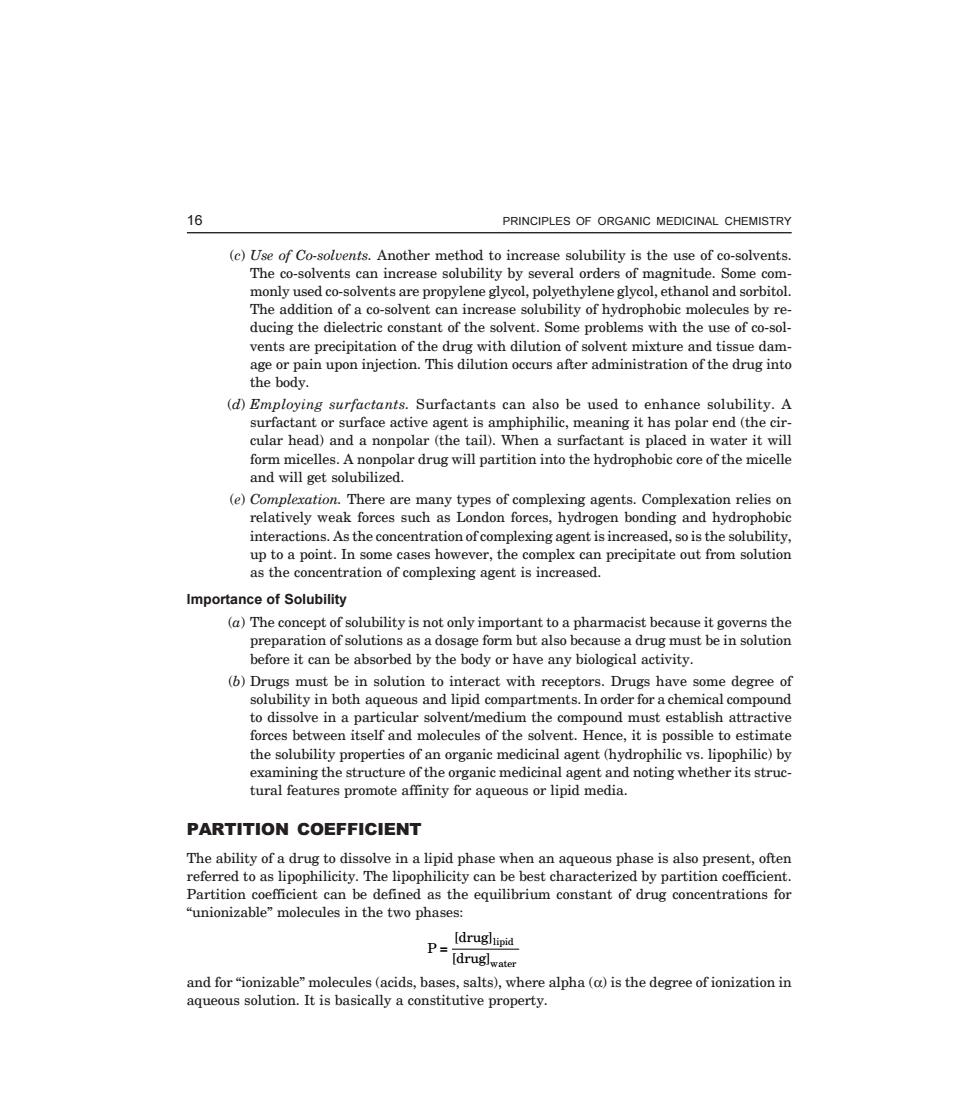正在加载图片...

16 PRINCIPLES OF ORGANIC MEDICINAL CHEMISTRY (c)Use of Co-solvents.Another method to increase solubility is the use of co-solvents. The co-solvents can increase solubility by several orders of magnitude.Some com monly used co-solvents are propylene glycol,polyethylene glycol,ethanol and sorbitol. The addition of a co-solvent can increase solubility of hydrophobic molecules by re- ducing the dielectric constant of the solvent.Some problems with the use of co-sol- vents are precipitation of the drug with dilution of solvent mixture and tissue dam age or pain upon injection.This dilution occurs after administration of the drug into the body. (d)Employing surfactants.Surfactants can also be used to enhance solubility.A surfactant or surface active agent is amphiphilic,meaning it has polar end(the cir- cular head)and a nonpolar (the tail).When a surfactant is placed in water it will form micelles.A nonpolar drug will partition into the hydrophobic core of the micelle and will get solubilized. (e)Complexation.There are many types of complexing agents.Complexation relies or relatively weak forces such as London forces,hydrogen bonding and hydrophobic interactions.As the concentration of complexing agent is increased,so is the solubility, up to a point.In some cases however,the complex can precipitate out from solution as the concentration of complexing agent is increased. Importance of Solubility (a)The concept of solubility is not only imp armacist because it ns the ration of solution before it can be absorbed by the body o or have any biological ac ous and lin e i st establis 10ra0 at and 05 the oili prope agen (hy ofth organi tural featu eous or lipid media. oting w res r PARTITION COEFFICIENT se is als resen city.The east y can ypartit on co equilibrium constant of drug concentrations nhas =drug and for"ionizable"molecules(acids,bases,salts),where alpha(a)is the degree of ionization in aqueous solution.It is basically a constitutive property. 16 PRINCIPLES OF ORGANIC MEDICINAL CHEMISTRY C-8—N-CHEMI\CHE3-1.PM5 (c) Use of Co-solvents. Another method to increase solubility is the use of co-solvents. The co-solvents can increase solubility by several orders of magnitude. Some commonly used co-solvents are propylene glycol, polyethylene glycol, ethanol and sorbitol. The addition of a co-solvent can increase solubility of hydrophobic molecules by reducing the dielectric constant of the solvent. Some problems with the use of co-solvents are precipitation of the drug with dilution of solvent mixture and tissue damage or pain upon injection. This dilution occurs after administration of the drug into the body. (d) Employing surfactants. Surfactants can also be used to enhance solubility. A surfactant or surface active agent is amphiphilic, meaning it has polar end (the circular head) and a nonpolar (the tail). When a surfactant is placed in water it will form micelles. A nonpolar drug will partition into the hydrophobic core of the micelle and will get solubilized. (e) Complexation. There are many types of complexing agents. Complexation relies on relatively weak forces such as London forces, hydrogen bonding and hydrophobic interactions. As the concentration of complexing agent is increased, so is the solubility, up to a point. In some cases however, the complex can precipitate out from solution as the concentration of complexing agent is increased. Importance of Solubility (a) The concept of solubility is not only important to a pharmacist because it governs the preparation of solutions as a dosage form but also because a drug must be in solution before it can be absorbed by the body or have any biological activity. (b) Drugs must be in solution to interact with receptors. Drugs have some degree of solubility in both aqueous and lipid compartments. In order for a chemical compound to dissolve in a particular solvent/medium the compound must establish attractive forces between itself and molecules of the solvent. Hence, it is possible to estimate the solubility properties of an organic medicinal agent (hydrophilic vs. lipophilic) by examining the structure of the organic medicinal agent and noting whether its structural features promote affinity for aqueous or lipid media. The ability of a drug to dissolve in a lipid phase when an aqueous phase is also present, often referred to as lipophilicity. The lipophilicity can be best characterized by partition coefficient. Partition coefficient can be defined as the equilibrium constant of drug concentrations for “unionizable” molecules in the two phases: P = [drug] [drug] lipid water and for “ionizable” molecules (acids, bases, salts), where alpha (α) is the degree of ionization in aqueous solution. It is basically a constitutive property.����